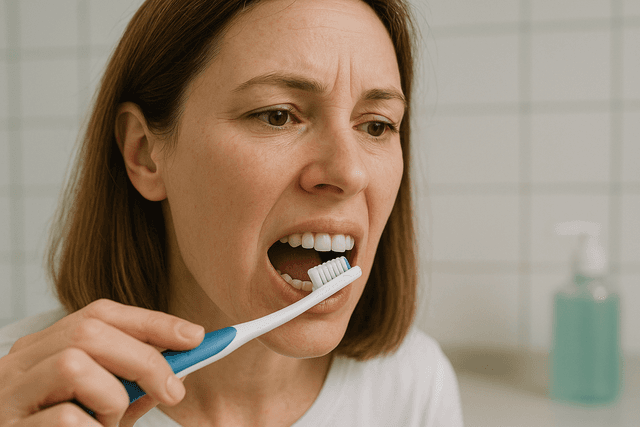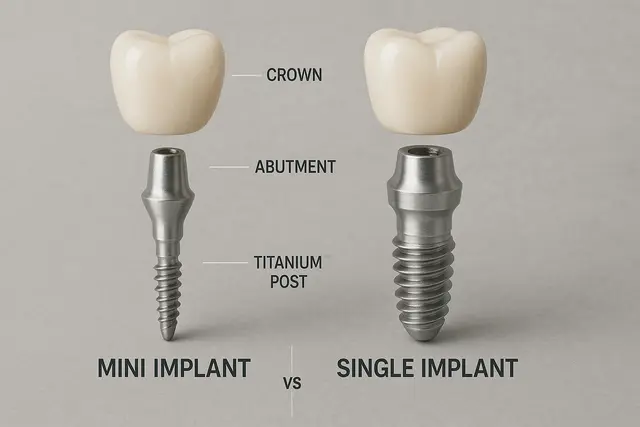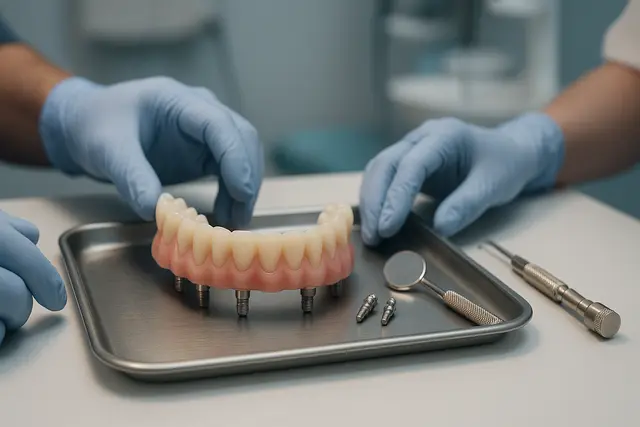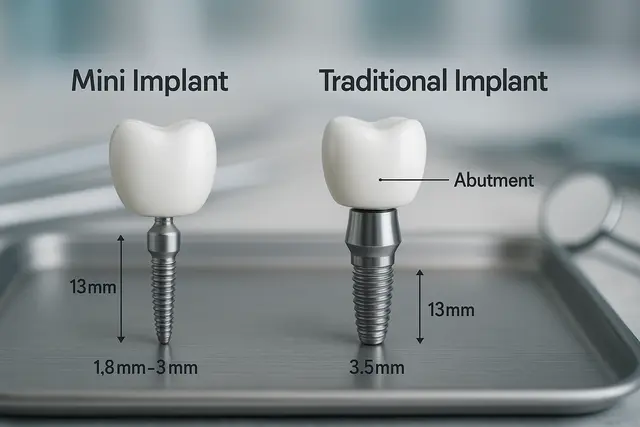Prosthodontics
6 min read
May 22, 2025
Best Toothbrush for Crowns: Keep Your Smile Safe and Clean
If you’ve just gotten a crown or are thinking about one, you probably have a few questions, starting with how to keep it clean without damaging it. Spoiler alert: not all toothbrushes are created equal. Choosing the right toothbrush can make a big difference in protecting your crown, your gums, and your overall dental health.

Why Your Toothbrush Matters More After Getting a Crown
You just invested in a shiny new crown, so the last thing you want is a rough-and-tumble toothbrush scraping away at that perfect fit. A good toothbrush should feel like a gentle handshake, not a wrestling match. That’s true whether you’re brushing natural enamel, a fragile veneer, or the ceramic cap perched on your molar throne.
We’ll walk through every angle, bristle strength, handle tech, electric versus manual, and throw in a few jokes so you don’t grind your teeth. By the end, you’ll know exactly how to keep your teeth and gums happy, how to remove plaque without drama, and why choosing a toothbrush that fits your lifestyle can help your new crown last for many years.
Electric Toothbrushes: Are They Worth It for Crown Care?
Fans of the electric toothbrush swear by its little motor doing the heavy lifting. Many electric toothbrushes come with timers, pressure sensors, and a brush head that vibrates thousands of times per minute. That speed helps remove more plaque around your dental work without sawing back and forth like a lumberjack. Plus, an electric brush is a good pick for people with dental arthritis or anyone who wants to keep their arm from aching while they scrub every side of their teeth.
If you decide to use an electric toothbrush, let the motor do the job. Hover; don’t saw. Moving too fast defeats the design and can scrape the gum. Most electric toothbrush models pulse every 30 seconds so you hit all quadrants evenly.
Understanding Dental Health Beyond the Brush
Let’s zoom out. Your overall dental health doesn’t start or stop with a single device. Think routine cleanings at a trusted dental clinic, talking to a dental professional about customized care, and following up on any dental treatment quickly. Regular dental exams allow your dentist to spot early cracks in a crown or an implant that’s starting to wiggle. Questions about dental insurance aside, prevention still costs less than fixing a surprise tooth loss later.
Great oral hygiene habits include using dental floss daily, rinsing with fluoride mouthwash, and swapping your toothbrush after getting sick to avoid reinfection.
How to Care for Your Dental Crown with the Right Toothbrush
A crown is strong but not invincible. Too much pressure, a hard toothbrush, or stiff bristles can chip the edge where porcelain meets gum tissue. Around crowns, stick with a soft toothbrush or an electric toothbrush set to a gentle mode. Choose the right pressure; scrubbing like you’re cleaning a frying pan can lead to tooth sensitivity or micro-scratches that collect plaque and food particles.
A dental crown demands royal treatment. Glide the toothbrush head around the gum collar, then clean around contact points where food often wedges. Patients with crowns should replace any frayed brush head every three months, or sooner if bristles splay like a bad hair day. Regular use of a soft toothbrush helps avoid gum recession and keeps the seal between crown and tooth intact.
Manual vs. Electric: Choosing What Works Best for You
The classic manual toothbrush still has a loyal fan base. Using a manual brush can feel more natural and lets you control every stroke. Look for soft bristles, a slim handle, and, if you have a new crown, angled tufts that reach behind molars. Manual toothbrush devotees love the quiet experience compared with a buzzing electric model, and many say it’s easier to stash a regular toothbrush in a travel kit.
You may wonder if a regular toothbrush beats a flashy electric brush. For people with dental sensitivity, a manual brush with soft bristles gives great feedback, you feel the gum and can adjust instantly. Meanwhile, an electric toothbrush helps folks with limited dexterity or anyone craving a built-in timer.
The Importance of Bristles and Brush Head Design
Soft bristles are non-negotiable when you have veneers, dental restorations, or a delicate dental crown. Hard toothbrush filaments might blast off stubborn stains, but they also erode enamel and irritate gum tissue. A bristle toothbrush with polished, rounded tips wins every science fair when it comes to protecting both crown margins and natural teeth.
No matter the handle, always angle the brush at 45 degrees to the gum and sweep in tiny circles. Brush your teeth twice a day, ideally after breakfast and before bed. Don’t forget the sides of your teeth that hide behind your cheeks, those areas collect plaque and food particles fast. And yep, brush your tongue; it’s the dance floor where bacteria throw nightly parties.
Toothbrush Types and Technology You Should Know
There are more types of toothbrushes available today than flavors at an ice-cream shop: sonic toothbrush, chewable toothbrush, eco-friendly bamboo, travel-size, pet-shaped for kids. Each type of toothbrush tries to solve a slightly different problem, speed, portability, or fun. For patients with crowns, a sonic model or a traditional soft toothbrush with soft bristles tends to clean around ceramic edges without scratching.
Toothbrush technology has leaped ahead recently. Pressure sensors blink red if you press too hard. Sonic motors create gentle vibrations that whisk plaque away without harsh scrubbing. Some oral-b models even light up with a smiley face when you hit the two-minute mark.
Traveling without water? A chewable toothbrush can save the day. Bite, chew, and the tiny bristles clean your teeth and other hard-to-reach spots. It’s not a crown-care routine you should rely on forever, but it beats letting plaque throw a festival while you camp under the stars.
How to Choose the Right Toothbrush for Your Dental Needs
To choose the right brushing gear, start with your personal dental needs. Do you have a dental implant or sensitive gum tissue? Maybe you’re simply tired of nagging plaque build-up along the gumline. The right toothbrush balances gentle contact with enough power to sweep away biofilm. For many people with dental crowns, a sonic toothbrush earns top marks. But the best to consult for final approval is still your implant specialist.
It can feel like lab work: choosing a toothbrush among neon handles, celebrity endorsements, and buzzwords like sonic or charcoal. Keep it simple, choose the right toothbrush with soft bristles, a small brush head, and a comfy grip. Anything else is bonus.
At the end of the day, the best toothbrush is the one you’ll reach for without grumbling. Pick a color you love, a texture that feels right, and stash extras so you’re never tempted to keep a shabby, germ-laden stick.
Brushing Isn’t Everything, Keep the Big Picture in Focus
Floss lines matter, folks. Floss once before bed to clean around crown margins and implants where a brush head can’t squeeze. Pair that with fluoride toothpaste to strengthen enamel and protect the neck of your new crown. If you’re using a sonic toothbrush, let it hum along each surface for two seconds, then glide along the gum.
Remember the golden rule: always a good idea to replace any toothbrush when bristles fray or after an illness. Microbes love damp nylon more than teenagers love wi-fi.
Ask your dentist if you feel stuck. They’ll factor in any implant, veneer, or other dental restorations and suggest a toothbrush that fits your mouth shape and chewing style. People with dental anxiety often find that a simple regular toothbrush paired with calm technique works better than an intimidating gadget.
Smile Insurance: How Daily Habits Protect Your Crown
Good oral care means more than brushing. Drink water, chew sugar-free gum to stimulate saliva, and schedule regular dental checkups. Lead to tooth problems early, and you’ll spend less time in the chair and more time flashing that confident grin.
Teeth twice a day, floss at night, and keep your toothbrush after getting a cold no longer than four weeks. Around your dental crown, stay gentle but thorough. If you still have questions, reach out, we love talking tooth talk.
And yes, choosing a toothbrush might feel overwhelming with so many electric and manual options on the market, but that’s okay. The variety exists because every smile is unique. So pick what feels right, stick with regular use, and keep your teeth happy. Your crown, and every other tooth, will thank you.
What Type of Toothbrush Is Best for a Dental Crown?
A soft-bristled toothbrush, manual or electric, is best for caring for a crown. It protects the delicate area where the crown meets your gums, preventing micro-scratches and irritation. Look for a small brush head and rounded bristles for the gentlest clean around the crown’s edges.
Are Electric Toothbrushes Safe for Crowns and Other Restorations?
Yes, most electric toothbrushes are safe for crowns, especially when used with a gentle setting and soft bristles. Let the motor do the work, hover rather than scrub. Features like pressure sensors and timers help prevent over-brushing and improve plaque removal around your dental work.
How Often Should I Replace My Toothbrush or Brush Head?
You should replace your toothbrush or electric brush head every three months, or sooner if the bristles look frayed. Worn bristles lose cleaning power and can be harsh on gums and crown margins, increasing the risk of gum irritation and plaque buildup.
Can a Hard Toothbrush Damage My Crown?
Yes, hard-bristled toothbrushes can cause micro-abrasions on the crown’s surface and irritate gum tissue. Over time, this can lead to gum recession and compromise the crown’s fit. Always stick with soft bristles to preserve both your dental work and your gum health.
Read Next
Related Posts

Prosthodontics
Single Implant vs. Mini Implant: Key Differences, What Sets Them Apart
Missing teeth can impact everything from your confidence to your ability to eat comfortably. Thankfully, dental implants offer effective solutions, but not all implants are the same. Understanding the difference between a single implant and a mini implant can help you make the right choice for your needs.
5 min read
Oct 22, 2025

Prosthodontics
Permanent Fixed Implant Dentures Overview: Best Solution for Full-Mouth Restoration
Gone are the days when dentures meant bulky, uncomfortable teeth soaking in a bedside glass. Modern dentistry has completely transformed the way we approach tooth replacement, offering solutions that are more natural-looking, stable, and long-lasting than ever before.
5 min read
Oct 22, 2025

Prosthodontics
Mini Implants vs. Traditional Implants: How They Work and When to Choose Each
Missing teeth can impact more than just your appearance, they can affect your confidence, oral health, and ability to enjoy everyday activities like eating and speaking. Fortunately, dental implants offer a reliable solution. But when it comes to choosing between mini implants and traditional implants, the differences can be surprisingly significant.
5 min read
Oct 21, 2025
Don’t have time to research every dentist around you?
See why 30k+ patients trusted us